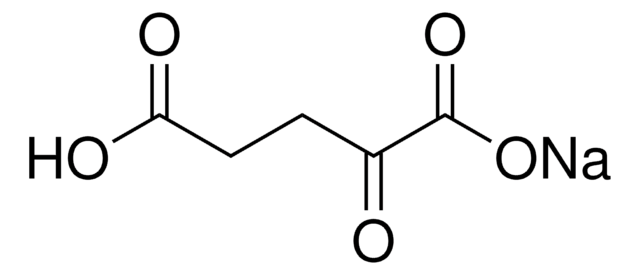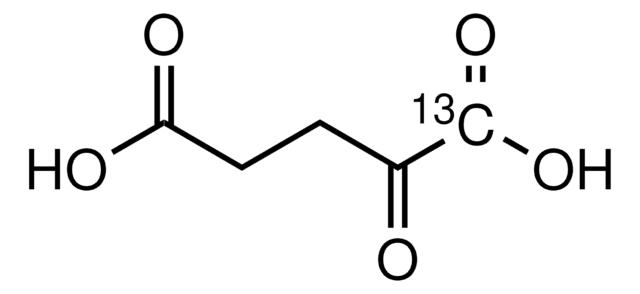K1128
α-Ketoglutaric acid
BioReagent, suitable for cell culture, suitable for insect cell culture
Sinonimo/i:
2-Oxoglutaric acid, 2-Oxopentanedioic acid
About This Item
Prodotti consigliati
Nome Commerciale
BioReagent
Saggio
≥98.5% NaOH basis (titration)
Forma fisica
powder or crystals
tecniche
cell culture | insect: suitable
cell culture | mammalian: suitable
Solubilità
water: 100 mg/mL, clear to slightly hazy, colorless to almost colorless
Temperatura di conservazione
2-8°C
Stringa SMILE
OC(=O)CCC(=O)C(O)=O
InChI
1S/C5H6O5/c6-3(5(9)10)1-2-4(7)8/h1-2H2,(H,7,8)(H,9,10)
KPGXRSRHYNQIFN-UHFFFAOYSA-N
Cerchi prodotti simili? Visita Guida al confronto tra prodotti
Descrizione generale
Applicazioni
- as a supplement in minimum essential medium α (α-MEM) to culture primary mesenchymal stromal/stem cells (MSCs) to study its effects on age-related osteoporosis
- for chemical treatments to compare the treatment effects of several compounds on lifespan between manual and automated lifespan machine (ALM) platforms
- as a printed chemotaxis ligand to screen chemotaxis receptors with high-throughput technologies and verify the interactions with surface plasmon resonance (SPR)
Azioni biochim/fisiol
Avvertenze
Danger
Indicazioni di pericolo
Consigli di prudenza
Classi di pericolo
Eye Dam. 1
Codice della classe di stoccaggio
11 - Combustible Solids
Classe di pericolosità dell'acqua (WGK)
WGK 3
Punto d’infiammabilità (°F)
Not applicable
Punto d’infiammabilità (°C)
Not applicable
Dispositivi di protezione individuale
dust mask type N95 (US), Eyeshields, Gloves
Certificati d'analisi (COA)
Cerca il Certificati d'analisi (COA) digitando il numero di lotto/batch corrispondente. I numeri di lotto o di batch sono stampati sull'etichetta dei prodotti dopo la parola ‘Lotto’ o ‘Batch’.
Possiedi già questo prodotto?
I documenti relativi ai prodotti acquistati recentemente sono disponibili nell’Archivio dei documenti.
I clienti hanno visto anche
Il team dei nostri ricercatori vanta grande esperienza in tutte le aree della ricerca quali Life Science, scienza dei materiali, sintesi chimica, cromatografia, discipline analitiche, ecc..
Contatta l'Assistenza Tecnica.













